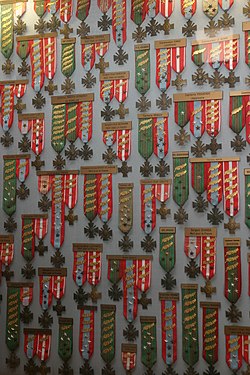This article has multiple issues. Please help improve it or discuss these issues on the talk page . (Learn how and when to remove these messages)
|

Military awards and decorations are distinctions given as a mark of honor for military heroism, meritorious or outstanding service or achievement. [1] A decoration is often a medal consisting of a ribbon and a medallion.
Contents
Civil decorations awarded to military personnel should not be considered military decorations, although some orders of chivalry have civil and military divisions. Decorations received by police and fire brigade personnel may sometimes be considered alongside military decorations, on which they may be modelled, although they are strictly not military awards.
Military awards and decorations may take the form of medal ribbons or miniature medals, which are mounted together on a bar known as a barrette. [2]



